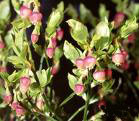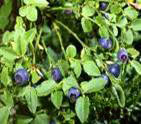| Kingdom | Plantae |
| Division | Magnoliophyta |
| Class | Magnoliopsida |
| Order | Ericales |
| Family | Ericaceae |
| Genus | Vaccinium |
| Species | V. myrtillus |
| Binomial name | Vaccinium myrtillus |
Other Common Names:
The other common names for the plant Bilberry are Black Whortleberry, Blueberry, Burren Myrtle, Dyeberry, Huckleberry, Hurtleberry, Whinberry, Whortleberry, Whorts and Wineberry.
History
Bilberry is a deciduous evergreen shrub which belongs to the heath family, and is related to the blueberry. The name of the genus Vaccinum is derived from the old Latin word, a name used in the works of the Roman playwrights Virgil and Pliny. Bilberry has a species name "myrtillus", this name is an allusion to the supposed resemblance of the bilberry leaves to the leaves of the myrtle plant. The name Bilberry is also said to be derived from the Danish 'bollebar,' meaning dark berry.


Description
The morphology of the bilberry is similar to the other berry bearing plants, being a small shrub that can reach about a foot in height with wiry angular branches. The leathery leaves which are oval and pointed are somewhat like those of the myrtle, are at first rosy, then yellowish-green, and in autumn turn red and are very ornamental which is been utilized to adulterate tea. The flowers which are in bloom from April through June are white globular and wax like. The flowers are hermaphrodite (have both male and female organs) and are pollinated by Bees, flies and Lepidoptera (Moths & Butterflies). The plant is self-fertile.



Range
Bilberry is a native of Europe and is found in Britain, Siberia and Barbary. It is widely distributed in Western North America, where it is found from British Columbia, southward to Utah all the way to parts of Arizona and up to New Mexico in the far south.
Habitat
Bilberry thrives best in Woodland, Sunny Edge, and Dappled Shade. It grows well at high altitudes and sandy or rocky soil surfaces. The plant can tolerate strong winds but not maritime exposure. The plant prefers acid soils and can grow in very acid soil.
Cultivation
Bilberry prefers a site that has good exposure to sunlight and gives the best berries at such sites; however, the herb successfully grows in areas in light shade as well. The normal mode of propagation is through seeds. Bilberry seeds are sown in late winter in a lime free potting mixture within a greenhouse - the seeds must be lightly covered with soil and not buried in the seed bed. A time period of upwards of three months may be required by stored seeds to overcome cold stratification. Cultivated plants are best grown in pots till they become well established and can then be planted out in their permanent positions in the garden. One study suggests that bilberry seeds are best sown inside a greenhouse as and when they ripen. As the seeds germinate and seedlings reach five centimetres in length, each of the seedlings can be pricked out into separate pots and then grown in a lightly shaded site within the greenhouse for their first winter. These seedlings can be planted out into their permanent sites late in the spring or in early summer, as soon as the last expected frosts of the year have passed. Bilberry cuttings can also be taken; cuttings of the half ripened wood, each at 5 cm - 8 cm including a heel can be taken in August and propagated on a frame. The cuttings from mature wood can be taken late in the fall. The bilberry can be subjected to layering late in the summer or early in the fall. One study states that the spring season is the best time to layer the plants. If the aerial parts are destroyed by being burnt they can regenerate quite well from what is left underground. Bilberry is also tolerant to some grazing from grazers and browsers.
Flowering Season
The white globular flowers of the Bilberry are in bloom from April through June.
Pests and Diseases
Wild animals and birds enjoy the berries and the plant is a source of food for a number of insect species wherever it grows. Most plants in this genus are resistant to the destructive honey fungus and can resist this parasite well. Recent research claims that bilberries are affected by a fungus like pathogen, Phytophthora kernoviae and Phytophthora ramorum.
Parts Used

The Bilberry fruits and the leaves are the most commonly used parts of the plant for its commercial and medicinal applications.
Medicinal Applications


• Bilberry has sometimes been used traditionally to treat heart disease and atherosclerosis.
• Bilberry extract has been used for a number of eye problems, including the prevention of cataract worsening.
• Bilberry fruits have a great reputation for strengthening and protecting capillaries and improving circulation making them a good choice for bruises.
• The fruits are astringent, and are especially valuable in diarrhoea and dysentery, in the form of syrup.
• The fruit is helpful in scurvy and urinary complaints, and when bruised with the roots and steeped in gin has diuretic properties valuable in dropsy and gravel.
• It is also used intreating diabetic retinopathy and prostatitis.
• Antioxidants have been shown to help prevent a number of long-term illnesses such as heart disease, cancer, and an eye disorder called macular degeneration.
• The skin of the fruits contains anthocyanin and is specific in the treatment of hemeralopia day-blindness.
• Bilberry may be helpful for relief of menstrual pain.
Commercial Applications

• Bilberry is commonly used to make jams, pies, cobblers, syrups, and alcoholic/non-alcoholic beverages.
• Fruit extracts are used as a colouring agent in wines.
• A green dye is obtained from the leaves and the fruit and is used to colour fabrics whereas a blue or black dye is obtained from the fruit which can be used as an ink.

In Ireland, the fruit is known as fraughan, from the Irish fraoch'n, and is traditionally gathered on the last Sunday in July, known as Fraughan Sunday. Bilberries were also collected at Lughnassadh in August, the first traditional harvest festival of the year, as celebrated by Gaelic people. The crop of bilberries was said to indicate how well the rest of the crops would fare in their harvests later in the year.
In Elizabethan times, bilberries were mixed with honey and made into a syrup called rob that was prescribed for diarrhea and stomach problems. It is used traditional desert in Britain where they are used for flavouring reciepes like Crepes, Vosges and Massif Central bilberry tart.